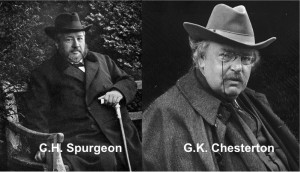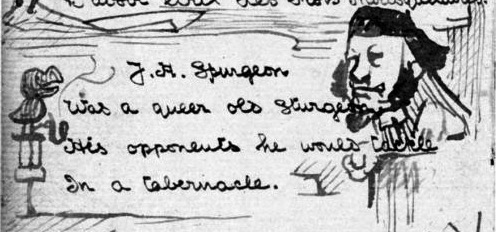 As a fan of both Chesterton and Spurgeon, I was curious to know whether or not the former ever mentioned the latter. As it turns out, he did so twice, and even drew a picture of Spurgeon.
As a fan of both Chesterton and Spurgeon, I was curious to know whether or not the former ever mentioned the latter. As it turns out, he did so twice, and even drew a picture of Spurgeon.
C.H. Spurgeon (1834-1892) was forty years old when G.K. Chesterton (1874-1936) was born. Chesterton was eighteen when Spurgeon died. That means that Chesterton was certainly aware of Spurgeon, though, again, in his voluminous writings, he apparently only mentions Spurgeon twice.
The first reference appears in one of Chesterton’s clerihews (a four line biographical poem). It can be found in Part 2 of Volume X of The Collected Works of G.K. Chesterton, edited by Denis Conlon. It should be noted that Chesterton collaborated with friends on these clerihews. This clerihew is signed “ECB & GKC, EC, WPHd’A.”
This reference is interesting because Chesterton made a mistake on Spurgeon’s initials. Here is what he wrote:
J.H. Spurgeon
Was a queer old sturgeon.
His opponents he would tackle
In a tabernacle.
In his footnote on this clerihew, Conlon writes:
Presumably C.H. Spurgeon (1834-1892) who was an English Baptist preacher of strong convictions.
This volume of Chesterton’s poetry also includes a facsimile reproduction of the clerihews as well as Chesterton’s accompany drawings. Here is Chesterton’s Spurgeon drawing:
We do not know the exact date of this clerihew, but it was before 1900. This is an interesting depiction, and it cannot be called a complimentary one. In the four lines and the drawing, Chesterton alludes to Spurgeon’s alleged oddness, bellicosity, and coarseness (“sturgeon”), and likely what Chesterton would have seen as his violent sectarianism (“His opponents he would tackle in a tabernacle.”).
A second reference to Spurgeon can be found in Chesterton’s 1903 essay, “The Return of Angels.” In this essay, Chesterton assembles a panoply of quite unlikely allies in an effort to demonstrate how otherwise disjoined personages are all in agreement on the existence of “the spiritual life.” Thus, “That Marcus Aurelius and the Red Indians, that Hindu sages and Italian brigands and Mr. Spurgeon and Sir William Crookes should all by various roads come to this conclusion, this is an important thing.”
Here Chesterton’s employment of Spurgeon’s name is purely utilitarian and is obviously intended to highlight the likelihood of the existence of the soul by pointing to the agreement on this point among such a disparate and unlikely lot.
In conclusion, Chesterton was clearly aware of Spurgeon and appears to have viewed him the way that a Catholic of the time would have: an interesting but somewhat unpleasant sectarian oddity. Thus, Chesterton’s depictions of Spurgeon would indeed appear to be unjust, or, at least, inaccurate, but likely not malicious. They arise almost certainly more from a stereotype than actual knowledge of Spurgeon’s amazing ministry.


Thank you for this! I’ve always wondered if GK had anything to say about CHS.
One slight correction…GK was not received into the Catholic church until the 1920’s, so I suppose general attitudes to fiery Baptists were similar among Anglicans.
Thank you so much for this comment as well as for the correction! You are absolutely correct. The youthful GKC would not have been a Catholic at the time. I’ve corrected it in the post. Thank you!
Thanks for this. I’m at Midwestern Sem, under which is Spurgeon College. Just listened to Orthodoxy. Was wondering what their relationship was. Prince of Paradox meets Prince of Preachers.
Thank you Joshua. God bless you in your studies. Orthodoxy is such a great book!